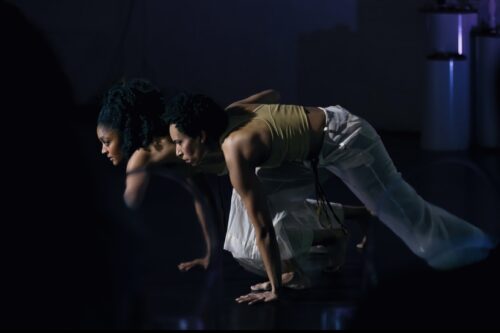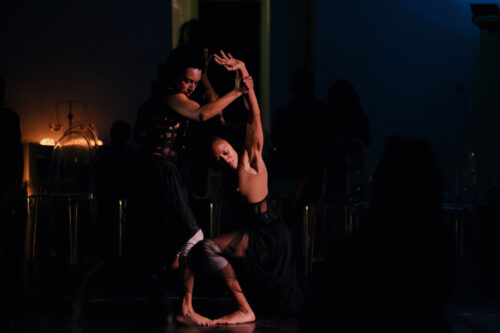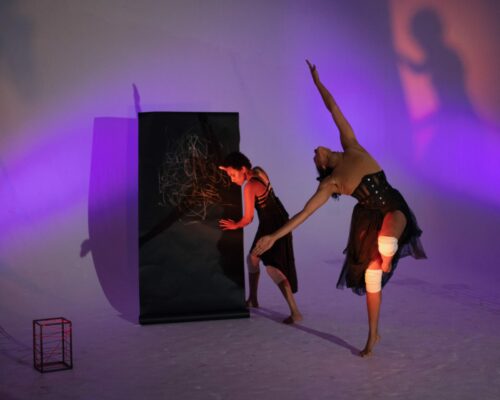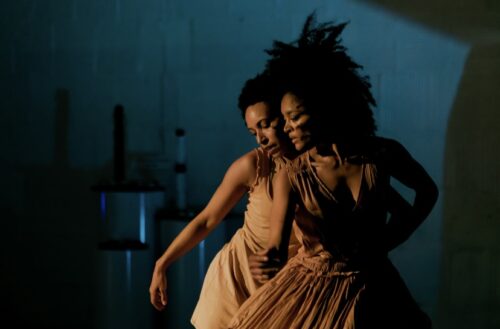LINEAR/FUNCTION: A Dynamic Gift from Crump and Collymore

Photo by Tati Vice Photography
On June 25th and 26th at Sanman Studios, artistic directors Kayla Collymore and Donna Crump premiered the second installation of LINEAR/FUNCTION: BORDERLESS, a live immersive, multi-disciplinary experience including dance, film, photography, and audience participation.
Collymore and Crump described LINEAR/FUNCTION as exploring the concept of bringing more balance to a world dominated by masculine energy via divine femininity, working with such themes and social constructs as gender, yin & yang: “We have no interest in holding either gender higher than the other; instead, we’d prefer to pursue the idea that regardless of gender, we can all possess nurturing, intuitive, empathetic, as well as courageous and assertive qualities.”

Photo by Tati Vice Photography
As audience members entered the space, they were encouraged to visit various stations around the venue before the production began. THE MAP asked audience to “Follow the ‘Floor Map’ as it ensures your journey to the end of the space. There you will find a visual that relates to yin and yang qualities. Write 1 word that best describes what you see.” A plate of different sized buttons was described as THE SCALES: Represents balance between 2 opposing energies. Balance the scales containing black and white buttons by adding red buttons to either side. BALANCE / STACKING ROCKS asked for audience to create more balance between opposing forces. How high can you stack the rocks with a red block being the last on top? My favorite was probably the INFUSION OF BLESSINGS, which provided various water vessels and asked audience to Take a jar full of water and balance the molecular structure of the water by saying a positive thought and prayer. (Repeat your mantra three times, then pour the water into an empty jar.) Finally, THE DANCE OF LIGHT & SHADOW asked for audience to create shadows on the wall with their bodies: The symbol for yin-yang comes from the yearly pattern of shadows cast by a long pole stuck straight up in the ground. Use the light to cast your own shadows.

Photo by Tati Vice Photography
LINEAR/FUNCTION moved back and forth from film to live performance. Within this stunning and interdisciplinary performance, Crump and Collymore brought in other immersive modes of art. The production also included audience participation, when audience members on both sides of the performers were asked to hold taught strings that the dancers manipulated in their movements. All of the performers—Crump, Collymore, and special guest Chianne Rae—brought a vibrant dynamism to the work that was unlike anything I’ve seen in Houston. The shift back and forth from the dance film works to the live performance felt fluid, surprising as I expected to feel disoriented moving through the different modes of the performance. The costumes throughout the piece were stunning and they each brought a sense of pedestrian softness while also many gave a sense of drama, of sharpness that suited the movement well.

Photo by Tati Vice Photography
However, if I were to give one reservation about the production, it would revolve around the conceptual framework of the production itself. I’ve found a disconcerting and evolving trend among contemporary and modern performances: the need to provide a concept or a theoretic framework to a particular dance production. I understand the need for this—it’s difficult to get a wide variety of audience members to a dance production without the tiresome question—what’s it about?—and, of course, funders and grant organizations are requiring art organizations to provide a conceptual or narrative language in order to receive funding. But in terms of LINEAR/FUNCTION, I personally did not find a clear exploration of yin & yang (and perhaps, as an Asian audience member who’s aware of how overused the American integration of yin & yang to be in general, I admit that concept felt a bit appropriative in this particular work) or a tension between masculinity and femininity. Although I enjoyed participating in the stations, and found them intriguing, I did not see a connection between what the different immersive stations asked from us and the work itself. I found the movement itself to be an intriguing and enjoyable tension between sharpness and fluidity, but I wouldn’t consider that masculine / feminine or yin / yang. However, I do think this work could organize its ideas to integrate these concepts if Crump and Collymore were particularly wedded to them, by including other dancers of varying gender and movement identities (as well as costuming that held the range of gender associations), and bringing more language and imagery that clearly connects to their conceptual interests. That being said, I did not find that LINEAR/FUNCTION needed these theoretical frameworks for the production to succeed—I found it to be an immensely stunning and enriching production and am eager to see what Collymore and Crump produce next.



Recent Comments